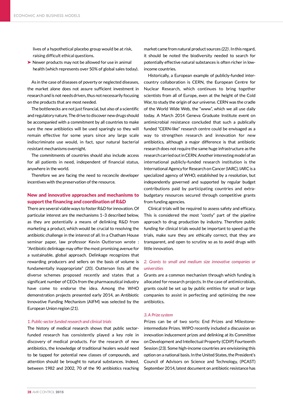
lives of a hypothetical placebo group would be at risk,
raising difficult ethical questions.
‰ Newer products may not be allowed for use in animal
health (which represents over 50% of global sales today).
As in the case of diseases of poverty or neglected diseases,
the market alone does not assure sufficient investment in
research and is not needs driven, thus not necessarily focusing
on the products that are most needed.
The bottlenecks are not just financial, but also of a scientific
and regulatory nature. The drive to discover new drugs should
be accompanied with a commitment by all countries to make
sure the new antibiotics will be used sparingly so they will
remain effective for some years since any large scale
indiscriminate use would, in fact, spur natural bacterial
resistant mechanisms overnight.
The commitments of countries should also include access
for all patients in need, independent of financial status,
anywhere in the world.
Therefore we are facing the need to reconcile developer
incentives with the preservation of the resource.
New and innovative approaches and mechanisms to
support the financing and coordination of R&D
There are several viable ways to foster R&D for innovation. Of
particular interest are the mechanisms 1-3 described below,
as they are potentially a means of delinking R&D from
marketing a product, which would be crucial to resolving the
antibiotic challenge in the interest of all. In a Chatham House
seminar paper, law professor Kevin Outterson wrote :
"Antibiotic delinkage may offer the most promising avenue for
a sustainable, global approach. Delinkage recognizes that
rewarding producers and sellers on the basis of volume is
fundamentally inappropriate" (20). Outterson lists all the
diverse schemes proposed recently and states that a
significant number of CEOs from the pharmaceutical industry
have come to endorse the idea. Among the WHO
demonstration projects presented early 2014, an Antibiotic
Innovative Funding Mechanism (AIFM) was selected by the
European Union region (21).
1. Public-sector funded research and clinical trials
The history of medical research shows that public sectorfunded
research has consistently played a key role in
discovery of medical products. For the research of new
antibiotics, the knowledge of traditional healers would need
to be tapped for potential new classes of compounds, and
attention should be brought to natural substances. Indeed,
between 1982 and 2002, 70 of the 90 antibiotics reaching
market came from natural product sources (22) . In this regard,
it should be noted the biodiversity needed to search for
potentially effective natural substances is often richer in lowincome
countries.
Historically, a European example of publicly-funded intercountry
collaboration is CERN, the European Centre for
Nuclear Research, which continues to bring together
scientists from all of Europe, even at the height of the Cold
War, to study the origin of our universe. CERN was the cradle
of the World Wide Web, the "www", which we all use daily
today. A March 2014 Geneva Graduate Institute event on
antimicrobial resistance concluded that such a publically
funded "CERN-like" research centre could be envisaged as a
way to strengthen research and innovation for new
antibiotics, although a major difference is that antibiotic
research does not require the same huge infrastructure as the
research carried out in CERN. Another interesting model of an
international publicly-funded research institution is the
International Agency for Research on Cancer (IARC). IARC is a
specialized agency of WHO, established by a resolution, but
independently governed and supported by regular budget
contributions paid by participating countries and extrabudgetary
resources secured through competitive grants
from funding agencies.
Clinical trials will be required to assess safety and efficacy.
This is considered the most "costly" part of the pipeline
approach to drug production by industry. Therefore public
funding for clinical trials would be important to speed up the
trials, make sure they are ethically correct, that they are
transparent, and open to scrutiny so as to avoid drugs with
little innovation.
2. Grants to small and medium size innovative companies or
universities
Grants are a common mechanism through which funding is
allocated for research projects. In the case of antimicrobials,
grants could be set up by public entities for small or large
companies to assist in perfecting and optimizing the new
antibiotics.
3. A Prize system
Prizes can be of two sorts: End Prizes and Milestoneintermediate
Prizes. WIPO recently included a discussion on
innovation inducement prizes and delinking at its Committee
on Development and Intellectual Property (CDIP) Fourteenth
Session (23). Some high-income countries are envisioning this
option on a national basis. In the United States, the President's
Council of Advisors on Science and Technology, (PCAST)
September 2014, latest document on antibiotic resistance has
ECONOMIC AND BUSINESS MODELS
28 AMR CONTROL 2015